ПОЗИЦИИ РОССИИ В МЕЖДУНАРОДНОЙ ТОРГОВЛЕ ПРОДОВОЛЬСТВИЕМ И СЕЛЬСКОХОЗЯЙСТВЕННЫМИ ТОВАРАМИ
Aннотация
Статья посвящена исследованию позиций России в международной торговле продовольствием и сельскохозяйственной продукцией. Выделены возможные направления улучшения конкурентных позиций России в международной торговле продовольствием и сельскохозяйственной продукцией с учетом последних тенденций развития мирового продовольственного рынка и обеспечения продовольственной безопасности России.
Ключевые слова: международная торговля, продовольствие и сельскохозяйственные товары, мировой рынок продовольствия, продовольственная безопасность страны
К сожалению, текст статьи доступен только на Английском
Introduction. The potential of the agricultural sector of any country can not always provide for internal needs of the population in food. All countries of the world are involved in the food and agricultural goods trade.
Russia is an active subject in the international trade of food and agricultural goods. The economic sanctions imposed against Russia address the issue of the country food security. A nagging question is arising: which is more important – a well established own production of food and agricultural goods and independence from imports or good logistics of the food and agricultural goods export.
FAO experts define food security as the most important guarantee of the right for life, it characterizes the ability of the state to satisfy the demand of the population for good-quality food and drinking water [1]. The criteria of safety determined by the Doctrine of food security of the Russian Federation are: production of 80-95% total amount of the main types of food at the expense of the countrie’s own resources; stocks no less than 20% of the requirement measured by the caloric content of daily diet; price and transport availability. Food independence is an ability to provide the country with food in case of complete or partial cessation of external supplies.
Preservation and strengthening of Russian food security require the objective understanding that the commodity structure of the food and agricultural goods export and import has to be changed taking into account the state interests. Respectively, the research into the Russia’s position in international trade in dynamics of food and agricultural production is rather timely.
Research objective. The purpose of the article is the research into the Russia’s position in international food and agricultural goods trade according to the latest trends of the world food market development and ensuring food security of Russia.
In the course of the research, there were used the methods of system analysis and synthesis, the logical, comparative, statistical and dynamic analysis, analogies and other methods.
Results and Discussion. The main tendencies of the world food market development in 2014 sharply differ from the previous periods of 2010 - 2013. The steady tendency of foodstuff prices reduction reaching an absolute minimum in 2015 is observed. An exception in this tendency is a group of goods "fish and seafood" for which the following is observed: change of product structure; steady rise of the prices which is connected with the increase in demand, stable US dollar; changes in culture of fish and seafood consumption.
Along with this, the world market of wheat is characterized by an increase in volume of export, despite the prices lower than the previous year. However, such situation will lead to the world reserves of wheat reaching the 13-year maximum in 2015.
On inclusiveness degree in international trade for the food and agricultural goods Russia is among the countries in general providing themselves with the food, but importing and exporting certain types.
Despite high potential for agricultural industry development, Russia has low positions in international trade in agricultural goods. During 2010 - 2014, the share of Russia in world export on this group of goods is in limits of 1.5 – 1.7%, in import of 2.2 – 2.6% (fig. 1). In the world market of the food Russia traditionally acts as net – the importer of agricultural production.
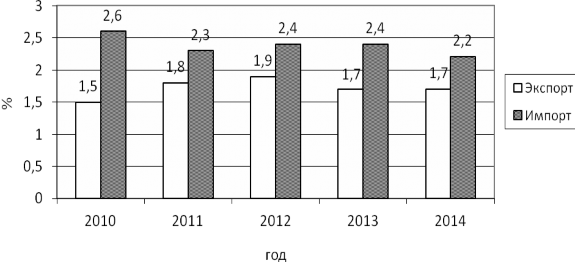
Source: compiled based on [7; 8]
Under Fig:
year

Fig. 1. Russia’s share in the global trade of food and agricultural goods in 2010-2014, %
Рис. 1. Доля России в мировой торговле продовольствием и сельскохозяйственными товарами в 2010-2014 гг., %
For the analyzed period of 2012 - 2014 the commodity structure of participation of Russia in world export of the food and agricultural goods underwent minor changes. In structure such commodity groups, as grain dominate (on average in three years of 3.65%); fish and seafood (on average in three years of 2.11%). In 2014 the share on commodity group increased in export: animal and vegetable fats (to 2.11%). On other food and agricultural goods the share of Russia in export is lower than 2.0% (table 1).
Table 1
Russia’s share in the global export of individual food and agricultural goods in 2012-2014, %
Таблица 1
Доля России в мировом экспорте отдельных продовольственных и сельскохозяйственных товаров в 2012 - 2014 гг., %
product group | 2012 | 2013 | 2014 |
Livestock | 0.05 | 0.07 | 0.12 |
Meat | 0.12 | 0.14 | 0.14 |
Dairy products and bird eggs | 0.39 | 0.37 | 0.35 |
Fish and seafood | 2.10 | 2.19 | 2.05 |
Grain products | 3.81 | 2.90 | 4.24 |
fruit and vegetable products | 0.29 | 0.24 | 0.25 |
sugar | 0.50 | 0.51 | 0.53 |
Coffee, tea, cocoa, spices | 0.78 | 0.97 | 0.84 |
Drinks | 0.50 | 0.50 | 0.47 |
oilseeds | 0.49 | 0.38 | 0.42 |
Animal and vegetable fats | 1.91 | 1.99 | 2.11 |
Other edible production | 0.98 | 1.06 | 1.05 |
Animal stern | 1.08 | 1.22 | 1.42 |
Source: calculated and compiled based on [9]
The leading role in formation of the world market food conjuncture tendencies belongs to grain. Russia acts as the large supplier of grain since 2002. – about 22 million tons, reaching a historical maximum in 2009. In grain export of Russia wheat (80%) and barley (20%) dominate [7].
By results of 2013/2014 MG Russia took the 5th place on output of grain crops and the 6th place in rating of the largest countries – exporters of grain. The fodder corn became the unexpected favorite of the year in Russian market. As a result Russia came to the 5th place on volumes of the world market corn export [5]. In 2014 Russia provided 14.0% of world wheat export, 18.2% - barley, 2.3% – corn (fig. 2). As for 2013, because of adverse weather conditions production and export of wheat decreased.
Table 2
Participation of Russia in the world production and export of grain, %
Таблица 2
Участие России в мировом производстве и экспорте зерновых, %
Product group | Production | Export | ||||
2013 | 2014 | 2015 | 2013 | 2014 | 2015 | |
Grain, including | 3.5 | 4.0 | 4.0 | 6.8 | 8.2 | 8.3 |
wheat | 7.0 | 8.1 | 8.1 | 11.5 | 14.0 | 15.0 |
barley | 11.2 | 14.2 | 12.1 | 13.1 | 18.1 | 14.1 |
corn | 1.0 | 1.1 | 1.3 | 2.4 | 2.3 | 2.9 |
Note: 2014 – assessment, 2015 – prognosis.
Source: calculated and compiled based on [1]
The largest foreign countries-buyers of Russian grain are the states of the Middle East (Iran, Saudi Arabia) and Africa (Egypt, Morocco, Algeria) act. From the CIS countries the main buyers of Russian grain are Azerbaijan and Armenia.
Competitive advantages of Russia in the grain international trade are caused by: existence of the world's largest arable lands resources and stocks of water resources; existence of the industry on mineral fertilizers production; territorial proximity to the regions of the world showing a growing demand for grain (the countries of Central and Southeast Asia, the Middle East, Southern Europe, North Africa).
At the same time export of grain faces a number of infrastructure restrictions. For example, lack of transshipment capacities in the Far East sharply limits access to the market of the Pacific Rim, strengthening administrative and technical barriers not only from the countries of importers, but also from national supervisory authorities, extremely high level of transaction expenses that is a consequence of the undeveloped competitive environment in the sphere of rendering services to the export companies.
Russia is included into group of leading exporters and importers of fish and seafood. On the volume of the exported production Russia concedes to Norway and China, because of export specifics of this production – production with low processing extent.
The nomenclature of import to Russia is much wider than of export. In large volumes meat and dairy products, fruit, tropical goods are imported. Balance of Russian trade balance in the food and agricultural goods foreign trade for 2010 - 2014 is negative. Positive aspect is reduction in 2014 in comparison with 2013 for 37.0% (fig. 3). The steady rise of a consumer demand in the conditions of slow internal capacities increase was the main reason for growth of import by the time of the analyzed period. The highest level of dependence on import is observed in the field of meat, vegetables and fruit production.
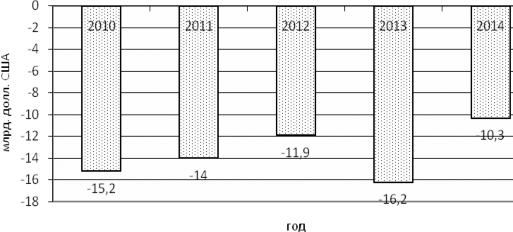
Source: calculated and compiled based on [3, 4]
Under Fig:
USD billion dollars
Fig. 2. Balance of Russia’s trade balance in foreign food and agricultural goods trade in 2010-2014, bln. dollars of the USA
Рис. 2. Сальдо торгового баланса России во внешней торговле продовольствием и сельскохозяйственными товарами в 2010-2014 гг., млрд. долл. США
To change positions of Russia in the food and agricultural goods international trade, in our opinion, is possible due to realization of the following directions:
1. Realization by the government of the country structural programs leading to redistribution of resources. For example, Russia, having competitive advantage in the offer of primary products (wheat, barley), can refuse them or displace accents in economic development of agricultural industry, having carried out industrialization and to make agricultural goods with a high value added.
2. Elimination of the main reasons for non-competitiveness of agricultural industry and agrarian sector in general, as main producer and supplier of agricultural goods: insufficient development of technical and economic production factors, non-optimal production structure, discrepancy of many organizational and economic actions to competitive forms of housekeeping.
3. Formation of the open competitive environment. To the Russian food producers matters of the world food market environment conceptual changes are important from outside, both offer factors, and demand factors. Domestic producers have to be familiar with conditions of the world food market and estimate the opportunities in comparison with other producers – competitors. Besides, research of the main tendencies and competitive environment of the world food market are a basis of the Russian food industry enterprises multinational strategy formation. For example, one of price indicators for agricultural staples food producers giving an impulse to reorientation in the short-term period from cultivation of one crop cultures or types of cattle on others is the ratio of price indexes on technological interchangeable objects of production. The most indicative price indicator is the price index ratio on grain and price index on olive cultures (in the period of relative stability the ratio of this index reaches 5-10%).
4. Transition to production of environmentally friendly agricultural production. Having relied on organic products, Russia will be able to become the world leader in this market. Further progress of agricultural industry, radical increase of grain crops productivity, productions of grain with the set consumer qualities, leveling of global climate change consequences becomes impossible without modern bio-technologies application.
5. The assessment of national agro-industrial complex development interests, self-sufficiency of the country by domestic food have to be estimated above temporary advantage of the "cheap" import food that rather convincingly is confirmed by a long experience of all traditionally large world food exporters. To the state, to producers and processors at this conjuncture it is necessary to use most effectively all opportunities for accumulation of volumes, range and quality of domestic production.
Expansion of export has to be provided not with the "self-sustaining growth", and creation of effective economy of "open" type, integrated into world economic system [8]. That is, Russia is faced by a task to achieve decrease in expenses of production and increase of competitiveness of the food and agricultural production in the world market in the shortest terms.
Positions of Russia in the world food market are directly connected with ensuring food security. At the heart of the country food security there are following elements: condition of internal production and import-dependence on separate groups of goods, existence of the food stocks in the country, and also a state and quantity of cultivated areas. All these elements are interconnected and supplement each other. Thus, internal production is the guarantor of providing the population with necessary food in case of low-quality import goods deliveries or in their general inaccessibility. The basis of internal production is made by existence of cultivated areas, the enterprises for processing and storage of the made products. Active participation in world trade insures the country at crop failures. Existence of food stocks though is a temporary, but effective measure of compensation and elimination of sudden food shortage.
Conditions of food security achievement are [6]:
- potential physical availability of food to each person, that is food existence and offer in sufficient;
- economic possibility of the food acquisition for all the population social groups, including poor (solvency of consumer demand);
- consumption of quality food in quantity corresponding to a balanced diet.
The food security except social aspects concerns the economic. On one hand, ensuring food security is a basis of manpower renewal maintenance. On the other hand, it promotes development of regional economy and industry that is possible due to maintenance of the agro-industrial complex enterprises financial stability by the tax concessions and other ways of stimulation effective use of their potential, environment and resources [6].
At the same time, it is necessary to consider the existing threats of social and economic character for food security of the country. The main social threat is the low purchasing power of the population caused by sharp differentiation of the income not only in spheres of employment, but also in regions. Economic threats are indicators of the agrarian and industrial complexes enterprises activity and efficiency of their potential realization.
Positions of Russia in international trade in the food and agricultural goods does not correspond to existing natural, labor and financial resources. It is necessary to pay attention to agricultural production and trade in agricultural goods, as the branch which is responsible for food security of Russia. Quite objective and possible is the development of agricultural production, and in the long term and foreign trade in agricultural goods as one of priority development directions of national economy. Besides, one of the main factors which dictates need of increase in agricultural production competitiveness of Russia is the entry of Russia into the World Trade Organization.
Conclusion. In the world market of the food Russia acts as net–importer. National production is almost completely focused on domestic market. For 2012 - 2014 the production structure of Russian participation in the world food and agricultural goods export underwent minor changes. In structure the following production groups dominate: grain; fish and seafood; animal and vegetable fats.
Russia holds the leading role in formation of the world market food conjuncture tendencies of grain export: wheat, barley, corn. That is positive dynamics for economy of Russia, however it does not promote adequately strengthening of competitive positions in the world food market.
At the considerable potential of agricultural production in Russia, there are problems of its rational use that leads to preservation of dependence on import of the food and, respectively, preservation of the country economic security threats. Actually, the food security of Russia is ensured by the principle "oil in exchange for food".
Under conditions of the imposed economic sanctions, Russia is faced by the task: to achieve decrease in expenses of production and to increase competitiveness of the food and agricultural production, both in the world market, and on the internal in the shortest terms. Thus, expansion of export has to be provided not with the "self-sustaining growth", but by creation of effective economy of "open" type, integrated into world economic system taking into account ensuring food security of the country.











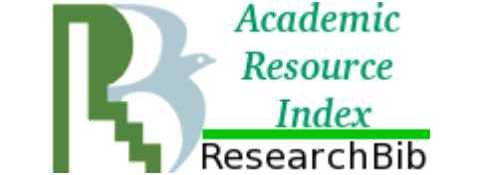

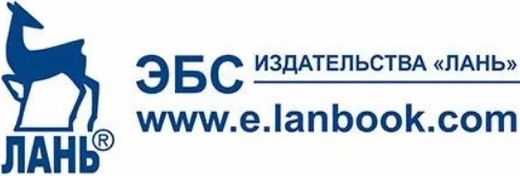
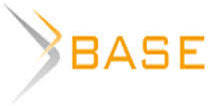


Список литературы
Список использованной литературы появится позже.